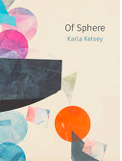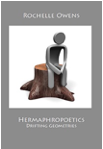Of Sphere
Karla Kelsey
Essay Press
$12.95, 104 pp.
November 2017

Hermaphropoetics, Drifting Geometries
Rochelle Owens
Singing Horse Press
$18, 178 pp.
March 2017

In very different ways these two collections—Kelsey’s book-length “proem” (her Prelude) of prose ruminations interspersed with lyric poems, Owens’ book-length poem organized around mathematical objects and concepts—ponder the problem of perception in relation to the presumptions that underpin the “obvious,” the superficial, the prison-house of routine, all targets, historically, of both “bookish” religions and philosophical phenomenology. For both writers these fundamental limits of perception redound first and foremost upon the ideological stakes in sexual differentiation, or what amounts to the same thing, the naturalization of cultural norms. Owens’ approach is terse, laconic, couplets (and occasionally, tercets) driving a series of phrases that get repeated in different textual environments, what we might understand as a building up of both the RNA and DNA of a bi-(not neutered) poetics. Kelsey’s approach is, per the allusion to Wordsworth and Coleridge above, effusive, expansive, even as it interrogates the boundaries within and between natural and cultural constructions.
In both books a central concern is visual perception, what it means to see: “Visual imagery reveals our habits of belief: lantern-like flowers compose English sentences while fuchsias depreciating in soil thrive on fish emulsion” (23). As this opening sentence from “Geosphere” suggests, Kelsey’s book circles the various ramifications of its title. “Of sphere” alludes to the habits of “study” as reason (-ology) and the commonplace English colloquialism “of course,” that epigram of ideology that reassures, seals a dialogue, and reseals any cracks opened up by the very act of speaking or writing to another person. In reminding us of the material foundation of the abstraction “of course,” the path of a vector or tangent as it moves within a preset trajectory (a river, an educational curriculum, etc.), eventually circling to, if not always, on, itself, however oblong, Kelsey calls attention to the reinforcements of the “obvious”: family, school, language, citizenship, and, above all, our relationships to the various spheres of the “earth” and “universe” (words no more innocent of history than water, fire or sky). At the same time, “of sphere” recalls the early modern conception of the universe as an “onion” of spheres, every sphere enclosing and enclosed except for the spiritual sphere of heaven, a pagan conception that Christian theologians struggled to reconcile with creation as depicted in Genesis (a finite structure enclosing infinite space and time). The Aristotelian conception of the four primary spheres—earth, water, fire, and sky—serves as the general scaffold for Of Sphere. The spheres can be “studied” separately (the specializations of the physical sciences) or, as “Proem” would have it, interactively. In this respect a Venn diagram would be a simplification of the complex layering, the multiple meldings, that Kelsey explores: flora, fauna, womanhood, parenthood, language, dance, art, cosmology, etc., all in relation to “Cosmogony,” the title of all the lyric poems. What links all these “beings” is a holistic ecology of (pre-Heideggerean) Being, spheres coursing through and transforming one another. Kelsey’s unflinching examination of mutability as the general condition of existence is at odds with her all too human desire for stability, both tendencies evident in nonhuman physical environs. There are several examples of this yin-yang dynamic throughout Of Sphere, but one of my favorites is an old, and rather obvious, one: the tug of war between centripetal and centrifugal forces in the natural world. Insofar as change is the condition for the possibility of a ‘sphere’ of ethos coursing through other spheres, an ecopoetics may spiral from apogee (“…”a knife-gash releasing plastic beads from the fish’s gut…”) to perigee (“,,,the immigrant who doesn’t yet speak English…”), but it must, suggests Kelsey, remain in motion, curving back out to where, “for no given reason, the hypothesis appears delicate, deliberate, imagines Earth came into being all at once, foggy and blue and complete in its rush toward outer space while simultaneously being held back by the expanding embrace of the sun.” (76) Just as that “expanding embrace,” an emblem of the hubris underlying “all at once,” portends the inevitable end of all life on earth by the source of life on earth, we too might become other than who we are by resisting the concretization of selfhoods: “Who might we be if we saw the ego-ideal not as a perfect image, but as a series of selves generating connective ideas, conduits for the nerve impulses of intercommunication, our bodies through language and gesture exchanging information of felt sense with one another, with animate and inanimate environments?” (105) Yet, Of Sphere is also a paean to the image, to the visible, that ‘small camera/strapped to [the] forehead.” (25) There are long sections on Kelsey’s investigations of, and enthrallment with, sculpture, painting, drama, and dance. No doubt the irresistible potency of the visual was already signaled in the title itself, in sphericity as such.
If Kelsey wanders back and forth between visible pleasures and invisible responsibilities, Rochelle Owens, avant-garde film/video artist, dramatist, and poet, narrows her focus unapologetically to the tyranny of the seen, how it obscures the unseen, in Hermaphropoetics, Drifting Geometries. Although the Preface proclaims that the book “is a series of poems of the five senses inspired by spores, fruiting bodies, and rupture,” the hegemony of sight, however inadequate, requires that the other four senses submit to the media of written and visual signs, a problem investigated a decade ago in the live presentation of Stacy Doris’ and Lisa Robertson’s The Perfume Recordist.[1] As we know from the canonical examples of writers like Sterne, Swift, Pope, Joyce, and Proust, as well as artists like Bourgeois, Piper, Hesse, and Sherman, elaboration and sensationalism are often the hallmarks of the attempts to depict the semiotics of the human body. Owens takes a different tack, deploying a laconic, minimalist strategy that, as we say, leaves more to the imagination. Owens examines the mathematics, specifically, topology, as a link between seeing and perception, the ways that ascriptions of identity calcify the seen into the familiar, the expected. Thus, the cover design, an abstract humanesque figure (four distended appendages and one oblong disk attached to a rectangular mass) “sitting” on a tree stump, serves as a template from which Owens extrapolates, on which she projects, respectively, a series of readings, not the least of which is sexual identity.
Of course, in calling the figure humanesque I too follow Owen in demonstrating the consequences of kinship, the metaphoricity (the figure resembles a human because it has four limps and a “head”) at the heart of kinship systems however defined. Owen demonstrates that “progress” aside, we have not come far from early modernity when the presumption dubbed the homunculus oriented a whole set of disciplinary fields (theology, philosophy, etc.). Against this conjoining of determinism and vitalism (e.g., Wordsworth’s “The Child is Father to the Man”), Owens detaches teleology from life (the undercarriage of identity), not only repositioning sexual difference from cause to effect but also blurring the binary polarities underpinning male/female difference. Doing so opens up space to explore the ramifications of this originary distinction: ethnocentrism, xenophobia, war, and so forth, modes of latent and actual violence mobilized to block a “one” from sliding into an “other.” The hermaphrodite is one manifestation of the slippery slope—e.g., the slippage of pronouns—one rushes down once sexual differentiation is neither originary nor permanent: “The camera zooms and pans // the dome of her skull / his earlobes//the angle of her nose/his fat ankles…”(13). Insofar as abstraction per se is the condition for the possibility of the hermaphrodite, Owens is able to read sexual hybridity as the erasure of that other foundational binary: nature (the eye) and culture (the camera). The relationship between female/male and nature/culture is, in this book, commutative, mutually enabling. Hermaphropoetics, Drifting Geometries demonstrates how the movements of seeing through different geometrics alters what we see, what we consequently assume as an underlining identity, the solidity of ground or a wall. However, if “out of a zigzag crack // known and unknown shapes / appear and disappear” (127) topology, for example, would confirm itself as a mathematical ideality inhospitable to the “drifting geometries” of material events. The abstract frame of topological thought would thus be the common denominator underlying the eye, the camera (photography, film, and video) and, per the fine arts, sculpture and painting.
Still, for all its superficial resemblance to Wallace Stevens’s “Thirteen Ways of Looking at a Blackbird,” Hermaphropoetics, Drifting Geometries is less a collation of philosophical speculations on an indomitable sense than an enactment of the conditions that give rise to it. I noted above the role that repetition plays in the structure of the book, but substitution is equally prominent as a strategy. Words and phrases are repeated within and between the various sections, all titled after mathematical objects (Angle, Circle), adjectives (Horizontal, Vertical) and cinematic directions (Pan, Zoom). As abstract concepts (many of these terms can function as nouns, adjectives and verbs), they facilitate the movement of words and phrases across a number of cultural and “natural” terrains. Thus, the references to those senses that defy perspective, problematize syntax, and thus “drift” across spatial and temporal fields, are generally articulated via metaphor (“the taste of her sweat / sea water”) (16) or parataxis (“sweat mucus tears urine”) (21). But it’s not only the senses that stand outside the frame of the eye/camera. Abstractions too must don the attire of materiality: “the logic of love/metal hammered into relief” (80). At the same time this dressing is itself subject to decay: “Painterly images/of afterlife//when mold/and a fungal taint//a montage of faults folds” (83). The one section that is not a mathematical object, perspective or direction, “Stump” marks a position, surveys a place, where the inertia of habit, the presumption of development, growth and movement, is blocked, halted. In this section the most important word may well be the adverb “when.” This word appears without an object, a verbal phrase or clause it would normally modify or condition. What blocks “when” from doing its normal syntactical work is “when” itself; the stuttering effect—“when like subatomic/particles when//when frame by frame/breakdown when//when burned/by its light source when…” (96)—articulating and enacting an entire series of social and cultural “disabilities” associated with incompletion, fragmentation and alienation.[2] What Owens does, however, is turn stigma back on itself. Here, the frame is arrested development, a narrow or delimited perspective. Like imagination, speculation, rendered here via substitution and repetition, opens out onto the territory uncharted by sight. But though the syntax of seeing tends to organize the ways we (the sighted) valorize smell, hearing, taste, and touch, we know from experience that any of the senses can be promoted or enhanced in a crisis or out of necessity (e.g., turning down the car radio when looking for an unfamiliar building address). Thus a “deaf mute” “feels the red/of heat the yellow of light // spirals of veins pulsate / sight small taste” (117). Of course, as Owens well knows, beyond the frame, after a rewiring of the senses, synesthesia, for example, is subject to diagnosis as physiological disorder (“zigzags of burning silver/ neurological linkings”) and revelation as mystical portal (“shards of glass form letters/ astrological symbols” [100]). There is nothing (nirvana) outside the book of the quotidian and exceptional: “every day bears the data / carnal / spiritual” (154),
[1] The Perfume Recordist was presented during the “Positions” conference at the Kootenay School of Writing in Vancouver, B.C., August 2008. More recently, Wendy Burks has investigated the problem of cross-species communication in a series of dendrological “interviews” in Tree Talks: Southern Arizona (2016).
[2] See my brief discussion of the stutter in the work of Jordan Scott and Jennifer Karmin, “Aestheticizing the Stutter,” at Harriet: The Blog (https://www.poetryfoundation.org/harriet/2017/04/aestheticizing-the-stutter)

